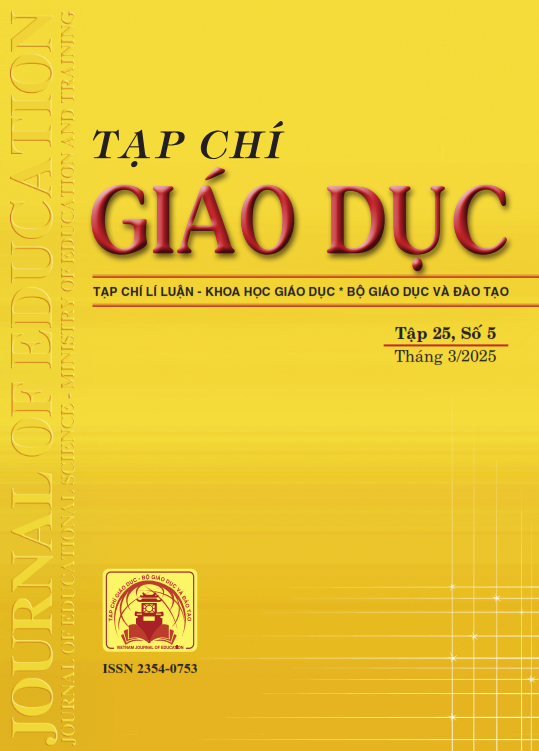Tổng quan nghiên cứu về đánh giá chất lượng dịch vụ giáo dục đại học dưới góc nhìn chi phí - lợi ích
Tóm tắt
The quality of higher education services is a key factor determining the sustainable development of educational institutions in the context where education has increasingly transformed into a service in response to the needs of the market and learners. The article synthesizes and analyzes related scientific works, thereby building a theoretical basis for developing a tool to assess the quality of higher education services from a cost-benefit perspective. Using the document review method, the article exploits reputable domestic and international academic sources to ensure a scientific and objective research approach. The research results not only complement the literature on assessing higher education services quality but also provide a practical foundation for designing effective measurement tools, supporting solutions to improve service quality, and optimizing training quality in educational innovation.
Tài liệu tham khảo
Abbas, J. (2020). HEISQUAL: A modern approach to measure service quality in higher education institutions. Studies in Educational Evaluation, 67. https://doi.org/10.1016/j.stueduc.2020.100933
Abdullah, F. (2005). Measuring service quality in higher education: HEdPERF versus SERVPERF. Marketing Intelligence & Planning, 24(1), 31-47. https://doi.org/10.1108/02634500610641543
Alzaid, S. (2016). The Kuala Lumpur stock exchange composite index (KLSE CI) and economic forces. South-East Asia Journal of Contemporary Business, Economics and Law, 10(3), 53-64.
Boardman, A., Greenberg, D., Vining, A., & Weimer, D. (2011). Cost-Benefit Analysis: Concepts and practice (4th ed.). Prentice Hall.
Brochado, A. (2009). Comparing alternative instruments to measure service quality in higher education. Quality Assurance in Education, 17(2), 174-190. https://doi.org/10.1108/09684880910951381
Brown, M. W., & Cudeck, R. (1993). Alternative Ways of Assessing Model Fit. In K. A. Bollen, & J. S. Long (Eds.), Testing Structural Equation Models (pp. 136-162). Newbury Park, CA: Sage.
Campbell, H., & Brown, R. (2003). Benefit-Cost Analysis: Financial and Economic Appraisal Using Spreadsheets. Cambridge University Press.
Chen, Z., & Dubinsky, A. J. (2003). A conceptual model of perceived customer value in e‐commerce: A preliminary investigation. Psychology and Marketing, 20(4), 323–347. https://doi.org/10.1002/mar.10076
Cocosila, M., & Igonor, A. (2015). How important is the “social” in social networking? A perceived value empirical investigation. Information Technology & People, 28(2), 366-382. https://doi.org/10.1108/ITP-03-2014-0055
Cronin, J. J., & Taylor, S. A. (1992). Measuring service quality: A reexamination and extension. Journal of Marketing, 56(3), 55. https://doi.org/10.2307/1252296
Đặng Thị Lệ Xuân (2017). Tính đầu tư của giáo dục đại học: Kinh nghiệm quốc tế và khuyến nghị cho Việt Nam. Tạp chí Kinh tế & Phát triển, 238, 92-102
Danielson, C. (1998). Is Satisfying College Students the Same as Decreasing Their Dissatisfaction? AIR 1998 Annual Forum Paper.
Harvey, L., & Green, D. (1993). Defining quality. Assessment & Evaluation in Higher Education, 18(1), 9-34.
Kotler, P., & Armstrong, G. (2010). Principles of marketing. Pearson education.
Latif, K. F., Latif, I., Farooq Sahibzada, U., & Ullah, M. (2019). In search of quality: Measuring higher education service quality (HiEduQual). Total Quality Management & Business Excellence, 30(7-8), 768-791.
Lu, Y., Yang, S., Chau, P. Y., & Cao, Y. (2011). Dynamics between the trust transfer process and intention to use mobile payment services: A cross-environment perspective. Information & Management, 48(8), 393-403. https://doi.org/10.1016/j.im.2011.09.006
Luo, J., & Photchanachan, S. (2022). Higher Education Service Quality for International Students: A Literature review. American Journal of Industrial and Business Management, 12(01), 1-9. https://doi.org/10.4236/ ajibm.2022.121001
Muhammad, N., Kakakhel, S. J., & Shah, F. A. (2019). Service quality a password of students satisfaction An application of hesqual model. City University Research Journal, 9(3), 586-607.
O’Neill, M. A., & Palmer, A. (2004). Importance-Performance Analysis: A Useful Tool for Directing Continuous Quality Improvement in Higher Education. Quality Assurance in Education, 12(1), 39-52. http://dx.doi.org/ 10.1108/09684880410517423
Phạm Thị Liên (2016 ). Chất lượng dịch vụ đào tạo và sự hài lòng của người học: Trường hợp Trường Đại học Kinh tế, Đại học Quốc gia Hà Nội. Tạp chí Khoa học, Đại học Quốc gia Hà Nội: Kinh tế và Kinh doanh, 32(4), 81-89.
Teeroovengadum, V., Kamalanabhan, T. J., & Seebaluck, A. K. (2016). Measuring service quality in higher education: Development of a hierarchical model (HESQUAL). Quality Assurance in Education, 24(2), 244-258.
Tri, L. D. M., Lam, T. T. H., & Trang, N. Q. (2021). Service quality in higher education: Applying HEdPERF scale in Vietnamese universities. Ho Chi Minh City Pen University Journal of Science - Social Sciences, 11(1), 101-115. https://doi.org/10.46223/hcmcoujs.soci.en.11.1.1905.2021
Ushantha, R. a. C., & Kumara, P. a. P. S. (2016). A Quest for Service Quality in Higher Education: Empirical Evidence from Sri Lanka. Services Marketing Quarterly, 37(2), 98-108. https://doi.org/10.1080/15332969. 2016.1154731
Viraiyan, T., Kamalanabhan, T. J., & Keshwar, S. A. (2016). An analysis of higher education service quality in Mauritius using HESQUAL. International Journal of Business Research, 16(2), 89-104.
Vũ Thị Kim Thanh (2024). Cơ sở khoa học của tự chủ tài chính trong giáo dục đại học dưới góc nhìn của kinh tế học. Tạp chí Thiết bị giáo dục, 312(1), 327-329.
Yang, H., Yu, J., Zo, H., & Choi, M. (2016). User acceptance of wearable devices: An extended perspective of perceived value. Telematics and Informatics, 33(2), 256-269. https://doi.org/10.1016/j.tele.2015.08.007
Zeithaml, V. A., Bitner, M. J., & Gremler, D. D. (2006). Services marketing: Integrating customer focus across the firm. Managing Service Quality: An International Journal, 14(5), 436-437. https://doi.org/10.1108/msq.2004. 14.5.436.1
Tải xuống
Đã Xuất bản
Cách trích dẫn
Số
Chuyên mục
Giấy phép

Tác phẩm này được cấp phép theo Ghi nhận tác giả của Creative Commons Giấy phép quốc tế 4.0 .












